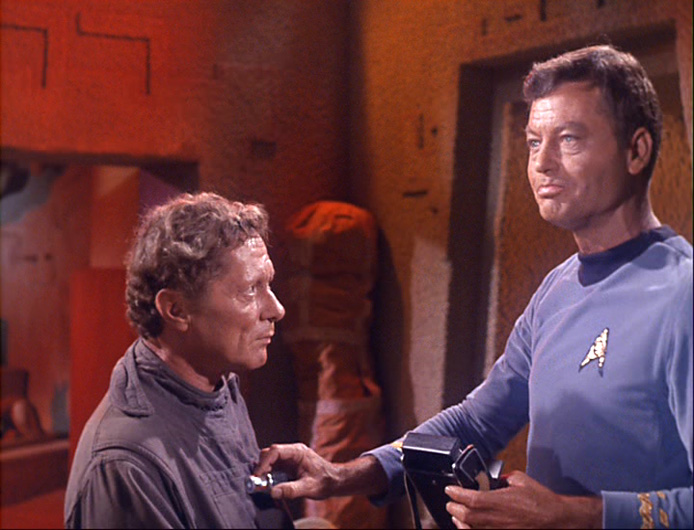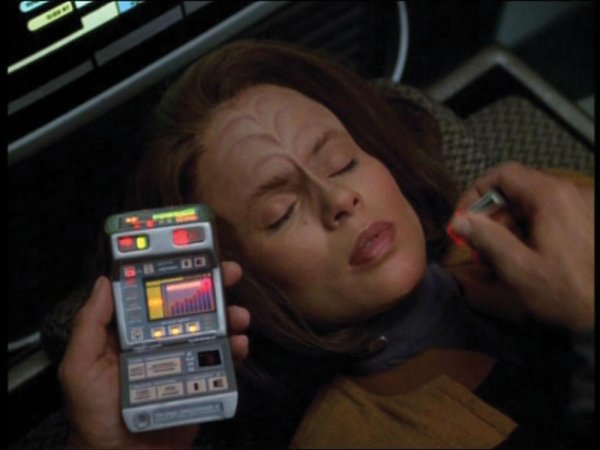
If you feel faint on the Starship Enterprise or your head starts spinning around, Bones McCoy would crinkle his brow in concern, take a step back, and scan you with the medical tricorder, a handheld device with a detachable scanner, kind of like a stethoscope without the ear pieces. The device would allow McCoy to collect your real-time bodily information, diagnose your condition, and administer medicine with the hypospray. The medical tricorder has evolved along with various Star Trek iterations, becoming smaller and sleeker, and presumably more accurate, and has played a key role in keeping both humans and aliens alive—pretty handy, given the lack of intergalactic EMTs and ERs. Such technology might do the same here on Earth, as real-life tricorders have progressed from campy phone apps to portable DNA labs and body scanners.
V-Sense Medical, a start-up founded by ex-NASA employee Jeff Nosanov, has developed something called the Sentinel Monitor. The basis of the device is NASA’s radar technology, which essentially functions as a tricorder for Earth. Nosanov worked at NASA’s Jet Propulsion Lab to figure out ways this technology could be used in clinical settings, and during his stint there, he had a baby who spent a week in the NICU. Because babies are so squirmy, it’s tough to get an accurate reading of their vitals, so Nosanov started thinking about how to use radar technology in a way that would do Bones McCoy proud.
The device works by beaming radar at a subject—namely, a person (unlike an X-ray, the process isn’t harmful). The device can register micro-movements, such as a baby’s tiny chest moving with its breath. In such movements, the device recognizes patterns, which it then can represent as respiratory or heart rate data. Unlike Bones’ tricorder, one doesn’t have to hold this device up to a person—it can detect this information from a distance, and without human intervention.

The Sentinel Monitor is also particularly useful for nursing homes, especially when a patient would benefit from continuous medical monitoring. The information harvested by the device can then be stored in a patient database, allowing doctors to identify patterns and problems that allow them to adjust and customize treatment. Nosanov’s device is the latest and most refined of a number of other tricorder-like technologies. Back in the late 90s, an accordionist named Jeff Jetton created a version of the tricorder for the Palm Pilot (remember those?) A party trick to amuse Trekkies with animations and accompanying beeps and boops, it planted the seed for the device to become a reality. A later iteration that could, at least theoretically, detect gravity waves, solar activity, and magnetic fields was developed into an app for Android phones.
In 1996, Vital Technologies manufactured the “Official Star-Trek Tricorder Mark 1,” which was equipped with a thermometer, a barometer, an electromagnetic field meter, a colorimeter, a light meter, a clock, and a timer. The company initially planned to make 10,000 units, but went out of business before finishing the run. And in case you’re wondering whether it was kosher for them to use the word “tricorder” for their product, apparently Gene Roddenberry signed a contract stating that if a company could duplicate the Star Trek device and make it function in the real world, they could use the name. If this isn’t incentive, I don’t know what is.
In 2008, Georgia Tech researchers demonstrated a hand-held multi-spectral imaging device that allowed people—not just doctors—to assess the severity of bruises, ulcers, erythema, and other sub-surface conditions regardless of lighting or skin color (darker pigmentation often makes such diagnoses more difficult).
That same year, a British company called QuantuMDx created a portable DNA lab designed to “provide an accurate molecular diagnostic result in 10-15 minutes” and has been improving the device ever since. It doesn’t function exactly like the medical tricorder—it requires a sample to be inserted into a cartridge, which is then inserted into the reader. The portable lab is especially useful in remote locations and in places where medical care is hard to find (like space!).

Gattaca genetic tester
A more sophisticated version of a similar device, the MinION, was released in 2015. It’s the tiniest model of them all and its capacity for real-time DNA, RNA, and protein analysis draws comparisons to the genetic testing equipment in Gattaca. The portable sequencer can be used for disease diagnosis and tracking, as it was during the recent Ebola epidemic; astronauts will take the device to the ISS sometime this year. The applications are endless when it comes to medicine, and could be used to identify everything from animal poachers to bacteria in foods, people, or objects. At $1,000, this device puts genetic sequencing capabilities into the hands of any scientist—or non-scientist. At some point, the device could foster another Gattaca comparison by being used to test the genes of potential partners or employees (although a 2008 bill made genetic discrimination illegal).
The desire to develop a portable device with the same broad diagnostic capabilities as McCoy’s tricorder prompted the X Prize Foundation and Qualcomm to announce a $10 million prize for the development of a “Tricorder device that will accurately diagnose 13 health conditions (12 diseases and the absence of conditions) and capture five real-time health vital signs, independent of a health care worker or facility, and in a way that provides a compelling consumer experience.” According to prize timeline, submissions were received in May 2014, 7 teams qualified as finalists, and consumer testing starts this September. I can’t wait to see what cool noises and lights these gizmos have. As much as a tricorder device would represent major strides in our ability to quickly and accurate diagnose disease anywhere, even in space, I’m still holding out for the replicator.
